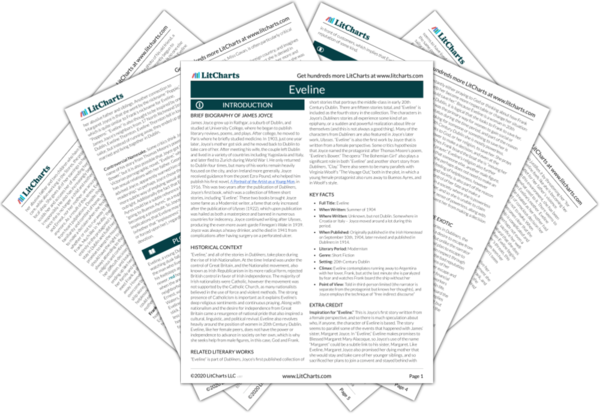Welcome to the LitCharts study guide on James Joyce's Eveline. Created by the original team behind SparkNotes, LitCharts are the world's best literature guides.
Eveline: Introduction
Eveline: Plot Summary
Eveline: Detailed Summary & Analysis
Eveline: Themes
Eveline: Quotes
Eveline: Characters
Eveline: Symbols
Eveline: Literary Devices
Eveline: Theme Wheel
Brief Biography of James Joyce

Historical Context of Eveline
Other Books Related to Eveline
- Full Title: Eveline
- When Written: Summer of 1904
- Where Written: Unknown, but not Dublin. Somewhere in Croatia or Italy – Joyce moved around a lot during this period.
- When Published: Originally published in the Irish Homestead on September 10th, 1904, later revised and published in Dubliners in 1914.
- Literary Period: Modernism
- Genre: Short Fiction
- Setting: 20th Century Dublin
- Climax: Eveline contemplates running away to Argentina with her lover, Frank, but at the last minute she is paralyzed by fear and watches Frank board the ship without her
- Point of View: Told in third-person limited (the narrator is separate from the protagonist but knows her thoughts), and Joyce employs the technique of “free indirect discourse”
Extra Credit for Eveline
Inspiration for “Eveline.” This is Joyce’s first story written from a female perspective, and so there is much speculation about who, if anyone, the character of Eveline is based. The story seems to parallel some of the events that happened with James’ sister, Margaret Joyce. In “Eveline,” Eveline makes promises to Blessed Margaret Mary Alacoque, so Joyce’s use of the name “Margaret” could be a subtle link to his sister, Margaret. Like Eveline, Margaret Joyce also promised her dying mother that she would stay and take care of her younger siblings, and so sacrificed her plans to join a convent and stayed behind with her abusive father and siblings. Another connection to Margaret Joyce is that she went by the nickname “Poppie,” which is quite similar to Frank’s nickname for Eveline, “Poppens.” “Eveline” is also thought to be inspired by one of James Joyce’s neighbors from 17 North Richmond Street in Dublin, Eveline Thornton. Eveline Thornton fell in love with a sailor, but instead of running away, they ended up getting married and living together in Dublin.
Controversial Namesake. Some critics think Joyce got the name of his story from Thomas Moore’s poem “Eveleen’s Bower,” but it is also possible that Joyce got the name from a Victorian pornographic novel, “Eveline,” where the protagonist has sexual relations with her father. George Russell, who advised Joyce, apparently warned him of “shocking his readership,” so perhaps Joyce chose the name “Eveline” as a more subtle way of implying sexual abuse, rather than stating it outright. Additionally the fact that Eveline is going to Buenos Ayres could be a subtle reference to the popular expression “going to Buenos Ayres,” as a euphemism for a woman becoming a prostitute. So Joyce has perhaps hidden some implications that Eveline may not have the most pious past (whether that “impiousness” was the product of her own choice or forced upon her), regardless of her apparent religious devotion.












